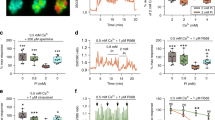Abstract
Calcitonin is a 3,500-molecular weight (MW) polypeptide whose main function in man is to protect the skeleton during growth, pregnancy and lactation1. It is secreted by C-cells which are localized in the thyroid in mammals, but may be present mainly in the ultimobranchial body and lung of more primitive vertebrates2. The hormone is also concentrated in the hypothalamus of several vertebrate species3,4, including man5, and in the primitive brain of the chordate Ciona intestinalis6,7. Based on cloning and subsequent analysis of recombinant DNA, recently we have reported the partial nucleotide sequence of the human calcitonin precursor mRNA8,9. This study showed that calcitonin resides towards the C-terminal end of its precursor protein, flanked by cryptic peptides of unknown significance. We now report that the synthetic C-terminal flanking peptide (PDN-21) predicted from the nucleotide sequence is highly active biologically—it approaches the potency of calcitonin in reducing the level of plasma calcium. As immunological evidence suggests that PDN-21 is synthesized in vivo and circulates in man, it may represent a novel hormonal cleavage product from the human calcitonin precursor with a physiological role in Ca2+ regulation.
This is a preview of subscription content, access via your institution
Access options
Subscribe to this journal
Receive 51 print issues and online access
$199.00 per year
only $3.90 per issue
Buy this article
- Purchase on Springer Link
- Instant access to full article PDF
Prices may be subject to local taxes which are calculated during checkout
Similar content being viewed by others
References
Stevenson, J. C., Hillyard, C. J., MacIntyre, I., Cooper, H. & Whitehead, M. I. Lancet ii, 769–770 (1979).
Ravazzola, M., Orci, L., Girgis, S. I., Galan Galan, F. & MacIntyre, I. Cell Biol. int. Rep. 5, 937–944 (1981).
Yui, R., Yamada, Y., Kayamori, R. & Fujita, T. Biomed. Res. 2, 208–216 (1981).
Galan Galan, F., Rogers, R. M., Girgis, S. I. & MacIntyre, I. Brain Res. 212, 59–66 (1981).
Fischer, J. A. et al. Proc. natn. Acad. Sci. U.S.A. 78, 7801–7805 (1981).
Girgis, S. I. et al. J. Endocr. 87, 375–382 (1980).
Fritsch, H. A. R., Van Noorden, S. & Pearse, A. G. E. Cell Tissue Res. 202, 263–274 (1979).
Allison, J., Hall, L., MacIntyre, I. & Craig, R. K. Biochem. J. 199, 725–731 (1981).
Craig, R. K., Hall, L., Edbrooke, M. R., Allison, J. & MacIntyre, I. Nature, 295, 345–347 (1982).
Nakanishi, S. et al. Nature 278, 423–427 (1979).
Comb, M., Seeburg, P. H., Adelman, J., Eiden, L. & Herbert, E. Nature 295, 663–666 (1982).
Tatemoto, K. & Mutt, V. Proc. natn. Acad. Sci. U.S.A. 78, 6603–6607 (1981).
Foster, G. V. et al. Nature 202, 1303–1305 (1964).
Gudmundsson, T. V., MacIntyre, I. & Soliman, H. A. Proc. R. Soc. B164, 460–477 (1966).
Amara, S. G., David, D. N., Rosenfeld, M. G., Roos, B. A. & Evans, R. M. Proc. natn. Acad. Sci. U.S.A. 77, 4444–4448 (1980).
Jacobs, J. W. et al. Science 213, 457–459 (1981).
Birnbaum, R. S., O'Neil, J. A., Muszynski, M., Aron, D. C. & Roos, B. A. J. biol. Chem. 257, 241–244 (1982).
Amara, S. G. et al. J. biol. Chem. 257, 2129–2132 (1982).
Amara, S. G., Jonas, V., Rosenfeld, M. G., Ong, E. S. & Evans, R. M. Nature 298, 240–244 (1982).
MacIntyre, I., Evans, I. M. A., Hobitz, H. H. G., Joplin, G. F. & Stevenson, J. C. Arthritis Rheum. 23, 1139–1147 (1980).
Reynolds, J. J., Minkin, C. & Parsons, J. A. Calcified Tissue Res. 4, 350–358 (1970).
Reynolds, J. J. in Organ Culture in Biomedical Research (eds Balls, M. & Monnickendam, M.) 355–366 (Cambridge University Press, 1976).
MacIntyre, I., Galante, L. S. & Hillyard, C. J. in Handbuch der Inneren Medizin Vol. 6, 1A (eds Kuhlencordt, F. & Bartelheimer, H.) 623–634 (Springer, Heidelberg, 1980).
Gindler, E. M. & King, J. D. Am. J. clin. Path. 58, 376–382 (1972).
Lawrence, R. Ann. clin. Biochem. 11, 234–237 (1974).
Dryer, R. L., Tammes, A. R. & Routh, J. I. J. biol. Chem. 225, 177–183 (1957).
Reichlin, M. Meth. Enzym. 70, 159–165 (1980).
Author information
Authors and Affiliations
Rights and permissions
About this article
Cite this article
MacIntyre, I., Hillyard, C., Murphy, P. et al. A second plasma calcium-lowering peptide from the human calcitonin precursor. Nature 300, 460–462 (1982). https://doi.org/10.1038/300460a0
Received:
Accepted:
Issue Date:
DOI: https://doi.org/10.1038/300460a0
This article is cited by
-
Evaluation of sensitive PDN-21 (Katacalcin) determination as tumor marker in medullary thyroid carcinoma
Journal of Endocrinological Investigation (1992)
-
The procalcitonin amino-terminal cleavage peptide (N-proCT) lacks biological activity on normal clonal rat osteoblastic and preosteoblastic cells in vitro
Calcified Tissue International (1991)
-
Calcitonin gene-related peptide inhibits osteoclastic bone resorption: A comparative study
Calcified Tissue International (1987)
-
Katacalcin — Ein neuer Tumormarker beim C-Zell-Karzinom der Schilddrüse
Klinische Wochenschrift (1987)
Comments
By submitting a comment you agree to abide by our Terms and Community Guidelines. If you find something abusive or that does not comply with our terms or guidelines please flag it as inappropriate.



